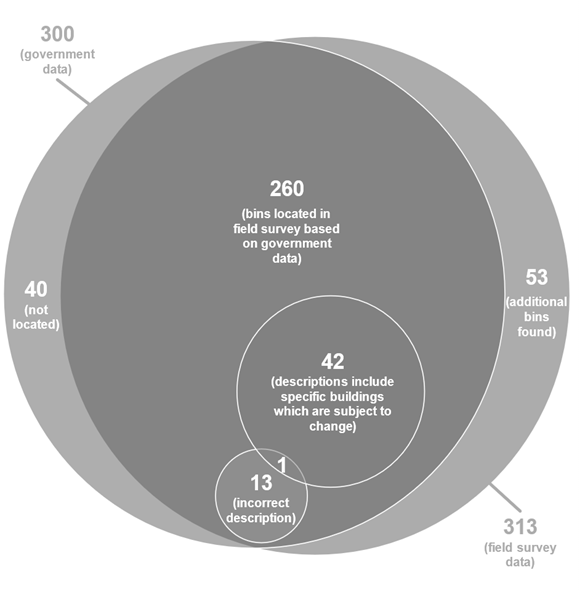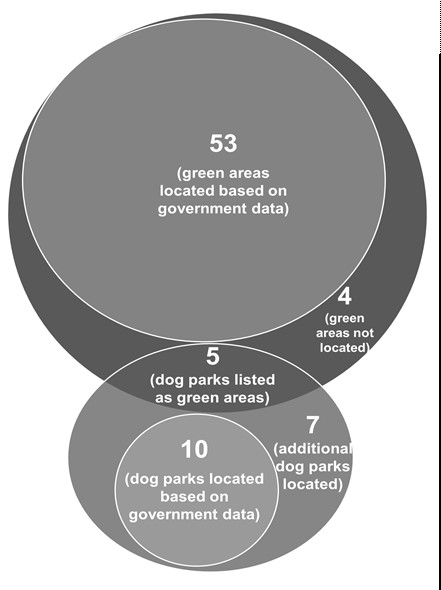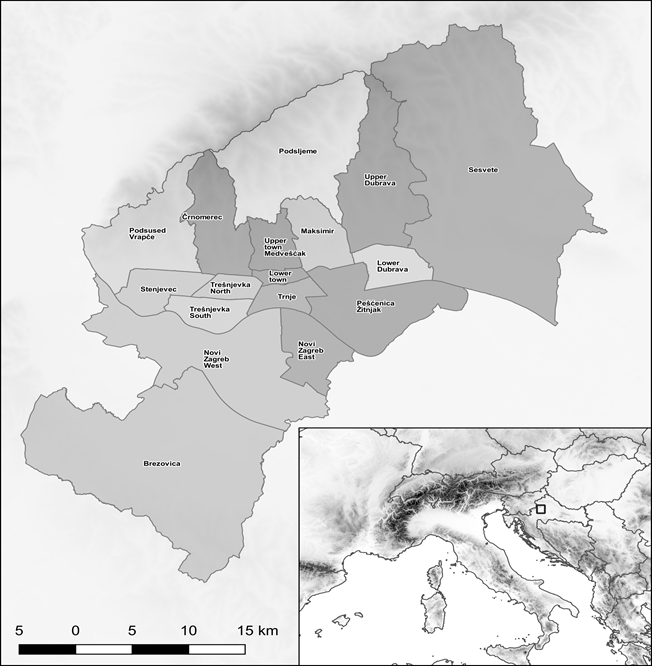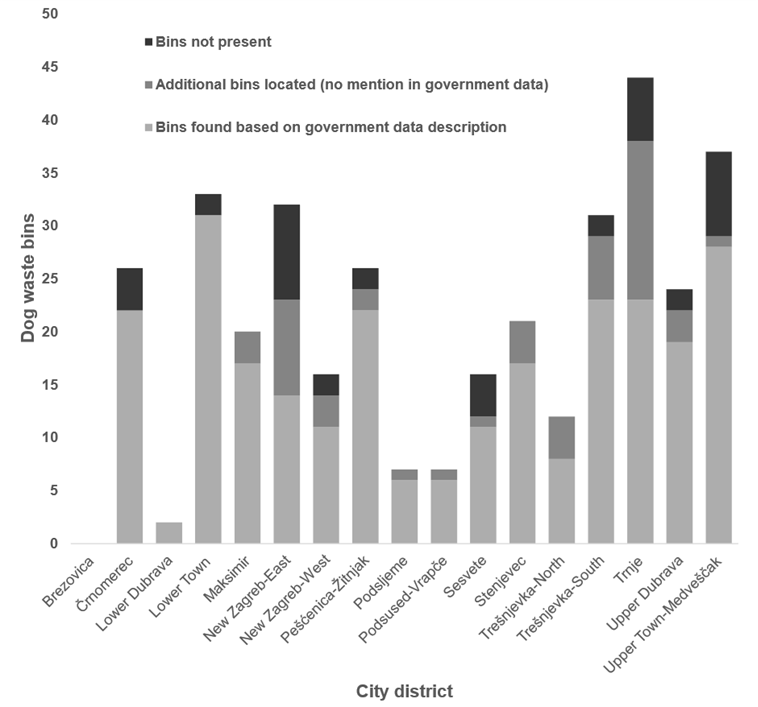INTRODUCTION
Dogs (Canis lupus familiaris Linnaeus, 1758) have been among man's most loyal animal companions since they were domesticated from their wild wolf ancestors 15 millennia ago[1]. As social structures have evolved throughout history, their popularity has continued to increase, and in recent years, dog ownership has peaked worldwide[2]. In addition, the notion that a dog's primary role is to guard the household and accompany its owners on hunts is now largely a thing of the past. Other benefits of dog ownership, such as companionship, social contact (with other dog owners), and time spent outdoors, are becoming more common, and the number of dogs in urban areas is increasing[3]. With this in mind, the need for a well-developed dog-friendly infrastructure in modern cities arises. Dog walking and using public spaces are the main activities of dog owners in urban areas[4]. With some exceptions, there is surprisingly little research on the development of urban infrastructure for dog owners. Most of the research to date has been aimed at examining the effects of dog ownership on social interactions[5].
In recent years, there has been a growing trend for cities to publish data according to Open Data standards, link data from multiple sources, allow citizens to generate and update data using mobile apps and application programming interfaces (APIs), and use this data in policy making[6]. Governments (local, regional, and national) have a great responsibility to inform their citizens about existing and developing infrastructures and services in an appropriate and user-friendly manner, and to allow citizens to express their needs[7]. As more and more citizens become computer literate, governments (both local and national) are under pressure to disseminate and collect important information via mobile apps[8], social media[9] or APIs[10]with more or less success.
As Open Data concepts that have been slowly but steadily implemented in Croatia over the last 10 years through policy making, development of data portals and formal obligation to publish data of public institutions, we finally see the positive trend of opening government data in various sectors. In terms of local governments, we can see that the larger cities are keeping up with the national trend, while other cities are significantly lagging behind in publishing their data[11]. Rijeka and Zagreb are definitely ahead in terms of opening data with 175 and 75 datasets opened, respectively from various categories such as locations of parking spots for cars and bicycles, bus stops, and educational facilities, to name a few[12],[13].
Dog-related government data in cities, presented in a simple and user-friendly manner, is of great benefit not only to existing dog owners, informing them of changes in dog infrastructure, but also to out-of-town visitors (e.g., tourists) navigating the city with their dogs. Another important stakeholder group that data relating to dog content would be of great interest is the bussiness sector aimed at dog owners, such as pet supplies stores, veterinary practices and dog grooming services in identifying city areas with great potential for expansion of their bussiness. The aim of this research was to determine the extent to which government information about dog-related content is available to end users, in what form, and the quality of that data. The research was based on a simple social question, "What dog-related content is available in the city of Zagreb?" in order to measure the maturity of the dog owner-focused open data ecosystem in Zagreb.
MATERIALS AND METHODS
To assess the openness of dog-related government data in the city of Zagreb, a mixed approach was used. In the first phase, various potential government data sources were identified and accessed. For the City of Zagreb, there are two open data portals through which municipal data can be accessed. One of them is the Open Data Portal of the City of Zagreb[13], where open data can be searched based on categories, tags, data formats and licence types. The second portal, ZG Geoportal – Zagreb Spatial Data Infrastructure[14], provides geospatial data for the territory of the City of Zagreb in interactive map and WMS (Web Map Service) formats with accompanying metadata catalogue. In addition, the City website[15], the City Services website[16], and the City of Zagreb Statistical Yearbook for 2020[17] were reviewed for dog-related datasets. All available datasets were downloaded regardless of the format in which they were available and where possible, ranked according to the five-star open data system[18]. Data from government sources were translated into a machine-readable table format (where necessary) and used as a starting point for the field survey.
In the second phase of this research, a field survey was conducted in 2020 (Fig. 1). To geocode open data from government sources, each location from the original datasets was visited and geographic coordinates were recorded using the Garmin Etrex Vista GPS device if the content was actually present at said location. Additionally, a Facebook community page Dog City Zg was created to build a community of dog owners[19]. Users were asked to send either geocoded photos, geographic coordinates, or descriptions of dog content locations in their neighbourhoods. The information received through the Facebook community page was additionally verified in the field and geocoded using the aforementioned GPS device in combination with satellite imagery, Google Maps, and OpenStreetMap platforms. Finally, the data from government sources and the data from the field survey were cross-checked with QGIS 3.10.7[20] to verify how accurate and up-to-date the data from open sources are for the city of Zagreb.
RESULTS AND DISCUSSION
The first phase of the research identified data on three types of dog-related content from various government data sources: Locations of dog waste bins, locations of dog parks, and locations of green areas where dogs can be walked off-leash.
The data on locations of dog waste bins were found on the website of the main service of the City of Zagreb responsible for waste management – Zagreb Holding, subsidiary Čistoća – under the heading Cleaning of public traffic areas[21]. The dataset was available in tabular form as a text-based PDF file without metadata, which was rated with one star on the five-star deployment scheme. The dataset contained the following information: Street name and number (if applicable), site description, district, and the number of bins per site. Although the dataset was available on both the Croatian and English versions of the website (and referenced in both languages depending on the preferred language), the data were presented in only Croatian. The dataset contained 293 records with information on 300 locations of dog waste bins (in some cases with multiple bins at one location) in 16 of 17 city districts. Several records indicated that there were no dog waste bins at a particular location. The district with the highest number of dog waste bins was Upper town-Medvešćak (36 bins), while no bins were recorded in government data for the Brezovica district, with an average of 17.7 bins per city district. When reviewing the ZG Geoportal interactive map, under the Green Space Cadastre group, the same data were observed in the Parks equipment layer[14], marked on the map as “other facilities”. When looking at more detailed information for the specific location of the bin, the type of equipment was defined as “dog equipment”, with no difference between dog waste bins and equipment elements such as platforms or crossbars. The layers in this group can be downloaded through the WMS service using various GIS (Geographic Information System) software, but only in the raster format without background data.
Data on the locations of dog parks and green areas where dogs can be walked off-leash came from three different sources in different formats. Although they are clearly defined as different concepts in the Statistical Yearbook of the City of Zagreb for 2020[17], the information about them was always available in a common dataset. The first source was the Decision of the City Assembly from December 2018 on the conditions and manner of keeping domestic animals and the manner of treatment of abandoned and lost animals and wild animals[22]. Article 17 of this decision lists 72 locations where dogs may be walked off-leash, including 10 dog parks. The decision was available as a text-based PDF file without metadata, rated with one star on the five-star deployment scheme, and was written exclusively in Croatian. At the end of the article, it states that a mapped representation of said locations will be published on the city's website. In fact, 22 static maps in PDF format named after the respective city area are published on the city website under the group Agriculture and Forestry, section Animal protection, subsection Domestic Animal Husbandry[23]. The maps show 66 localities, which are numerically identified on the maps. According to the information on the website, the maps were last updated in April 2017, which may explain the discrepancy in the number of locations between the two government sources. The data can also be found on ZG Geoportal under the Animal Welfare group in the Public Areas for Dogs layer[14]. A total of 72 locations are marked, but no detailed site information is available. The layer is marked as a new layer on the Geoportal and is currently not available for download via the WMS service.
All locations (300 dog waste bins and 72 off-leash dog walking areas) from available government data were reviewed during the field survey. The locations for which it was indicated that no bins were present were also reviewed. Of the 300 entries for dog waste bins, 260 were present at the described locations (Fig. 2). A large number of the descriptions (42)

included information about proximity to specific buildings such as grocery stores, phone booths, schools, daycares, etc. Only a few records (13) contained incorrect information about locations, such as incorrect or outdated street names, incorrect house numbers, or an incorrect number of bins at the location.
Records that could not be found based on the given description (40) include five waste bins that, according to government data, are located in a dog park that does not exist and five waste bins that, according to government data, are located in green areas around the fountains across from the National and University Library in Zagreb. Not only were the waste bins not present at this location, but there are also signs reading "Dogs not allowed" in several places around the green area. Thanks to the continuous reports of dog owners collected on the Facebook page Dog City Zg, another 53 dog waste bins were found 313 in total (Fig. 3).
The highest number of bins recorded in the survey was in Trnje district (38). The Brezovica district was not surveyed as there was no data to indicate that dog waste bins were located there and no information from the dog owners' community to indicate otherwise. The Lower Dubrava district was the only district where all dog waste bin locations could be successfully located from government data (2) and where no other dog waste bins were present during the survey (current data). Discrepancies between data and actual numbers were noted for other districts. For five districts, all locations were confirmed using government data, with additional waste bins found, indicating an improvement in infrastructure in the districts, but also that the data on dog waste bins had not been updated. In most districts, the number of dog waste bins has stagnated or increased, with the exception of the districts of Črnomerec, Lower Town and Sesvete, where the number has decreased since the last update (Fig. 4). The City of Zagreb provides a mobile application called “Razvrstaj MojZG” to inform citizens how to dispose of different types of waste, at what times waste is collected, etc.[24]. Within the application there is an interactive map with the locations of recycling centres and so-called green islands (areas where large recycling bins for glass, plastic and cardboard waste are located). The locations of dog waste bins would be a very welcome addition in one of the future updates to the application.
Field surveying revealed that there were 22 dog parks and 53 green areas where dogs can be walked off-leash. Of the 22 dog parks, 10 were listed in available government data (Fig. 5). An additional five dog parks were listed in the available government data as green spaces where dogs can be walked off-leash, rather than dog parks. The other 53 areas found were all present in the most recently found government data. Four areas from the list were clearly repurposed and the green areas were either non-existent (a school was built on one such area), fenced (Brodarski Institute), or the area was marked with “dogs prohibited” signs (the same area across from the National and University Library in Zagreb, where there were no dog waste bins). In addition, the descriptions of 13 green areas where dogs are allowed to be walked off-leash are not clear, making it difficult to easily find and accurately map them. For four areas, the descriptions are incorrect or outdated (wrong street address or the building near the area has changed its purpose and the entry has not been updated).

The field survey revealed that seven out of 17 districts of Zagreb do not have a dog park, while some districts have more than one (Pešćenica-Žitnjak has a whopping 6). On the other hand, all districts except Brezovica have access to one or more green areas where dogs can be walked off-leash, which is especially important for districts with few green areas like the Lower Town district. Another major drawback of the City of Zagreb's infrastructure for dogs is that the green areas where dogs can be walked off-leash are not marked in any way by a sign (with the exception of an area in the Maksimir Forest Park, which is under the jurisdiction of the Maksimir Public Institution), and violation of the city ordinance can be punished by a fine ranging from 80 to 270 euros[22]. According to McCormack et al, the proximity of dog parks and other green areas where dogs do not have to be leashed reduces the distance dog walkers travel, suggesting that they prefer them[25]. Publicly available data on this content would direct dog walkers' attention to content that is specifically targeted towards them. Comparing government data on green areas for dogs in Zagreb with Dutch cities such as Utrecht[26], The Hague[27], or Amersfoort[28], one can see the drastic difference not only in the way the data are available and presented to citizens, but also that some local governments recognise the value of these data and classify them as high value data[29]. What Zagreb and the Dutch cities have in common is that they provide the data and interactive maps only in the local language, which was to be expected since the providers are local governments. But with increasing globalisation, local governments should also reconsider this practise, considering how many foreigners visit their cities.
Although the initial results of this research indicate that dog infrastructure in the city of Zagreb is growing and developing, the pace at which the government is updating the data available to the public about this infrastructure is both slow and insufficient (poor description of locations, general description of content present at locations). A clear evidence of this is the sharp increase from 43 green spaces designated for dogs in 2016[30] to 72 in 2018[22]. Another positive indication is the list of 25 projects that have been or are currently being implemented to improve urban infrastructure for dogs[31], but according to our findings, publicly available data on dog-related content in the city of Zagreb is very outdated. Several media outlets report that in some dog parks in Zagreb there are constant attempts to poison or injure the dogs by inserting nails or glass inside of meat[32]-[34]. Information about such activities is crucial for dog owners when choosing their dog walking routes and the parks they visit, and it would be of great benefit to the dog owners community to make this information publicly available through the city portal.
The information collected through the survey is publicly available in the form of a Google thematic map[35]. These data are not only of high value to the city of Zagreb and the dog owners living there, but also show that local government must constantly evolve to deal with dynamic, open data sets that can change frequently. Apart from that, the data presented in this study is already outdated. At the time of this study, new dog waste bins were recorded in several neighbourhoods without updated government data available online. The Google thematic map created as part of this study is constantly updated based on contributions from the public via social media and provides more up-to-date information on dog-related content in the city of Zagreb.
CONCLUSIONS
The results suggest that the City of Zagreb urgently needs to change the way it manages data on dog-related content so that it is more useful to its citizens. The results suggest that there is a need to update the already open datasets more frequently, enrich them with new data and missing metadata, and potentially open additional datasets that would be of great benefit to the community of dog owners in Zagreb. Improved implementation of these datasets into existing city data portals would improve the availability and reuse of this data and increase the already high value potential of this data. A mobile or web application covering all dog-related content in the city area and offering the possibility to collect data from users would also be a step towards a smart city approach to city management.



